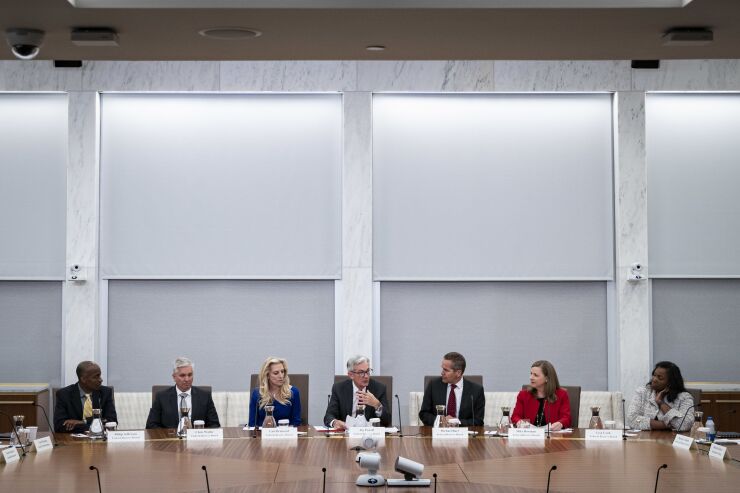
Futures traders expect the Federal Reserve to cut interest rates between four and six times this year, as a potential global trade war weighs on the U.S. economy. But some economists say the central bank should be preparing to raise rates instead.
Last week, President Donald Trump
For the Fed, the new trade policies threaten to disrupt both sides of what it calls its dual mandate — keeping prices stable and unemployment low — by supercharging inflation while also bringing economic growth to a standstill.
"The Fed is in a quandary here," said Arend Kapteyn, UBS's global chief economist.
During a briefing call on Monday, Kapteyn told reporters he does not expect the Fed to tighten monetary policy anytime soon. He said recent comments from policymakers about the need to look through one-time price shocks and their dismissal of survey-based indications of rising inflation expectations suggest they are still inclined to reduce rates when appropriate.
Still, Kapteyn said, the idea of tighter monetary policy cannot be dismissed entirely, especially after the Fed labeled post-pandemic inflation as "transitory." Attempting to look through the jolt of a one-time response to supply-chain constraints caused the Fed to delay responding to inflation, a mistake it is loath to make again.
Read more of American Banker's
"If these inflation expectations continue to increase in an exogenous way, the Fed will have to respond to that in some way, especially after what we saw in 2022, 2023 and 2024," Kapteyn said. "Inflation data will deteriorate before economic data and, if the Fed sees a few higher monthly inflation prints in a row, it could be forced to respond to maintain its credibility. That would complicate things further."
Based on the CME Group's Fedwatch tool — which tracks federal funds futures trades — market expectations about rate cuts have risen sharply in recent days, with more than 90% of trades pricing in at least 75 basis points of cuts this year, up from 53% after the Federal Open Market Committee's meet last month. More than 30% expect the Fed to cut more than a full percentage point before year end.
Kapteyan said UBS is projecting two quarters of year-over-year economic retreat to end 2025, leading to an uptick in unemployment. Other forecasters are also projecting a slowdown as businesses are stymied by the new trade barriers and struggle amid broader uncertainty.
Komal Sri-Kumar, a senior fellow at the Milken Institute and independent macroeconomic consultant, said the Fed is likely to cut rates multiple times this year in the face of both an economic downturn and a sharper rise in inflation. But, he said, doing so would be a mistake.
"Cutting rates with rising inflation will worsen stagflationary pressures and prolong the agony," Sri-Kumar said. "With the CME forecast of rate cuts more likely to occur this year compared with my prescription for a rate increase — especially if there are four to six cuts this year — inflation will accelerate further."
Other forecasters say the uncertainty created by the trade policies likely takes a rate cut off the table for 2025 but does not change the Fed's desire to ease monetary policy whenever possible.
Derek Tang, CEO and co-founder of the Washington-based research firm Monetary Policy Analytics, said his firm has revised its forecast from two cuts this year to zero — provided the U.S. does not slip into a deep recession.
Tang said there is a risk that if the Fed were to lower rates in response to a price uptick that would otherwise be a one-time shock, it could open the door to sustained higher inflation moving forward.
"The Fed's job is to make sure that the threat of higher inflation doesn't become self-fulfilling," he said.
Because of this, Tang said the Fed is likely to hold off on changing rates as long as it can. But, he added, that should the higher tariffs lead to job losses, he would expect the Fed to move swiftly to make its policy accommodative.
"This all sets up for a Fed that is probably going to stay put longer than it usually would, but once they start cutting they will cut much more quickly than usual, too," he said.
In public remarks last week, Fed Chair Jerome Powell said it is
"We will continue to carefully monitor the incoming data," Powell said. "We are well-positioned to wait for greater clarity."






